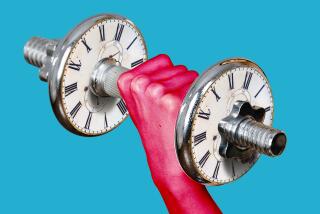Swimming with the fittest?
- Share via
Is swimming the best exercise for lifelong health?
I’ve always hoped so — for decades as a recreational swimmer and more recently, as a competitor in meets sponsored by U.S. Masters Swimming, a group of 50,000 similar enthusiasts ages 18 to over 100.
After all, you can swim with just your arms if you have a bum knee, or with just your legs if you have sore arms. You can swim with arthritis. Or a recently replaced hip.
So I was thrilled when I opened the May-June 2010 issue of Swimmer and found an article about a 2008 study by Steven Blair, a leading exercise scientist from the University of South Carolina.
This study, which involved 40,547 men ages 20-90 who completed health exams between 1971 and 2003, found that “swimmers had lower mortality rates than those who were sedentary, walkers or runners.” The study was funded by the National Institutes of Health and the National Swimming Pool Foundation and was published in a new peer-reviewed journal, the International Journal of Aquatic Research and Education.
It was the first time anybody had compared the long-term benefits of swimming with other activities — and my sport won.
But is swimming really better for you? And if so, why?
Blair himself, in a telephone interview, is cautious. The 13-year study, he says, does “show that swimmers have lower death rates” than sedentary people, walkers and runners. “That’s what the data show.” But swimmers being more fit than runners? “It doesn’t quite make sense to me,” he says with a laugh.
Over the course of the study, 1,336 of the 20,356 runners (or 6.6%) had died, compared with only 11 of the 562 swimmers (1.9%). “That small number of [swimmer] deaths could lead to erroneous conclusions,” he says.
In addition, the study was “observational” — that is, the researchers simply followed the different groups of people over time to see how they fared, as opposed to randomly assigning them to different interventions.
“My guess is that there were a lot of differences in the people who chose to be swimmers,” says Steven Woloshin, a professor of medicine at the Dartmouth Institute who analyzes the interpretation of scientific studies.
Building data
And though the study did classify the runners and walkers by pace, it didn’t specify swimming paces at all. I’ve spent a lot of time in pools, and believe me: Pace matters.
Some people dog paddle a bit and never get their hair wet, while others are dynamos — such as the 23-year-old guy who swam 50 yards (down and back in a normal pool) in 19.69 seconds at the recent U.S. Masters Nationals in Atlanta.
“The data are interesting because they look at different kinds of activities,” says I-Min Lee, an epidemiologist at the Harvard School of Public Health who also studies physical activity and health. “What is encouraging, though by no means definite, is that swimming may be more beneficial than other sports if that is supported by other data. There are so many things people can do. You can pick what you like. We’re not forcing everybody to run or play tennis.”
Peter Katzmarzyk, a professor of epidemiology at the Pennington Biomedical Research Center who also studies exercise and health, echoes that thought. “I can’t say everybody should be swimming as opposed to other things,” he says. But at the very least, the study shows that swimming “accrues the same benefits as other activities, and that was never shown before. It’s certainly as good if not better.”
In another 2008 study using treadmill tests and other measures of cardiorespiratory fitness, Blair’s team showed that while runners, both men and women, were the most fit, “the general pattern of fitness distributions was similar for swimmers and runners.”
On the downside, one of the chief benefits of swimming — being weightless in the water, a boon for aching joints — is also a disadvantage.
“Swimming does not build bone,” says Dr. Michael Holick, an osteoporosis expert at the Boston University School of Medicine. “It’s pounding the pavement that is translated to hip and spine bone strength. Even treadmills and elliptical machines are not the same,” he says.
On the other hand, he says, “there’s no evidence that swimming makes it [bone loss] worse.” And swimmers do develop good muscles, and muscle mass “usually equates with higher bone density.”
Stay on the go
The bottom line? The most important message is that physical activity is crucial for good health and longer life.
As Blair’s team notes, a sedentary lifestyle is a major risk factor for premature mortality from all causes. It’s also a risk for many chronic diseases, including Type 2 diabetes, cardiovascular disease and cancer.
Put the other way around, people who expend more than 1,000 calories a week in exercise cut their risk of dying — from all causes — by 20% to 30% within a given time period, and those who do more cut their risk even more. Physically active people have lower (healthier) fasting blood glucose levels, insulin resistance, and are better able to control their weight. They also have lower blood pressure, total cholesterol and “bad,” low-density cholesterol.
As for swimming per se? Even the most cautious interpretation of the data shows that it’s right up there with running as a great way to get and stay fit. And it’s certainly easier on the knees, a huge advantage for many people as they get older.
Besides, there really is something spiritual about sliding into the water, outdoors or in a pool, and moving quietly through it. After all, life evolved in the water. Why not head back in?
Read other articles by Judy Foreman at myhealthsense.com.






